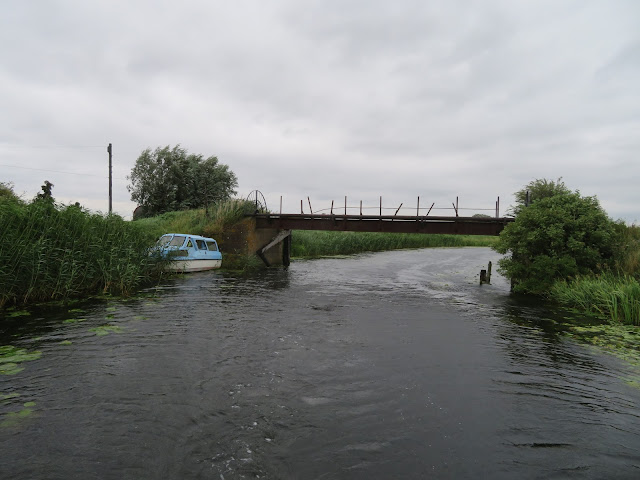We left March mid morning and west passed all the moored boats before turning into Fox Narrow Boats, as I needed fuel. It was not the cheapest but choice was now limited before heading out on the Wash. Getting in was okay, getting alongside the boat on the fuel point was also okay, but getting back out wasn't so easy with the wind and the limited room, but were were soon back on our way.
These are the new office of the Middle Level Commissioners just to the east of Fox Narrow Boats. The Weatherspoon's is now using the old offices as the hotel. The little weed boats look quite new, and unused.
This is Botany Bay Bridge. It is disused now as there is now track bed on it. It doesn't really reflect the place it was named after. The weather was quite gusty and with frequent drizzle. Helen stayed inside and baked another cake. Every rainy day has a sliver lining!
From the Old Course of the River Nene, which we are travelling on, it looks like there is very little around the area. As we approach Flood's Ferry Bridge the wind turbine reveals the site of the Greenvale facility who are one of the largest producers of potatoes and processors too.
In the previous photo you can just see this sign right on the bow of the boat. It reveals that we have been in the eastern hemisphere and are now crossing back into the west. I hope that Helen hasn't picked up any revolutionary tendencies, or eastern mystical ways, as I wont know where I am!
Just after Ferry's Flood Bridge the Old Nene slinks off to the left and we continue along the Whittlesey Dike. It is guarded by a WWII pill box. In the case of an invasion by German forces in WWII the main plan, if they managed to get a toe hold on the land, would be to restrict the limit of the breakout, and to prevent tanks moving out and across the land. The east coast was a prime spot for an invasion and there are many pill boxes along the drains and dykes inn the Fens as these would make natural obstacles for tanks,
Whittlesey Dike has it's own characteristic with many reeds and high banks, and only as wide as a 'normal' canal.
At Turningtree Bridge there is another pill box, showing that the crossings were guarded and the bridge was probably prepared for demolition in a hurry too.
We were soon at Ashline lock that seems to take ages to fill, and empty. There is a sign that says that the lock should be left empty but with the paddles down. The top gates are leaking so badly that it would soon fill up again I think. I did notice the old entrance to the lock on the down side was left when they extended the lock in 1998/99. There is a plaque that says it was largely carried out by 'direct labour'. From here we are on yet another waterway, Briggate River. The houses along its length face the water way which is nice to see. We found a mooring by the Leisure Centre with another boat.
We soon got out and wandered into the town. There are plenty of shops, not too far of a walk. The main feature of the Market Square is the Buttercross. It dates from 1680 but was thought to be redundant by the 1800's, and was to be pulled down until a local donated a load of slates to re-roof it. It is still going strong.
This building houses the museum on the ground floor. It started out as the Town Hall in the early 1800's and then also house the horse drawn fir engines. The museum was closed, but if it had been open I'm sure it would have been worth a look around. I love little museums.
There is a large conservation area in the town and effort being had to stop any loss of heritage. The Roman's built the Fen Causeway from Peterborough to March which went through Whittlesey which was another island in the fens. The majority of the buildings date from 17th/18th and 19th Centuries, with some high status buildings amongst them. The little place appears to be rich in nice buildings on the whole.
On the thatched roof just off Market Square is this figure. It is based on the Straw Bear ceremony that occurs around this part of Fenland and places in Germany too. It happens on the first Monday after Twelfth Night, Plough Monday, where a person is dressed up all covered in straw and is paraded around the town with a minder and a band. It faded out in about 1909, it is thought that the Police disapproved of the begging! It was resurrected in 1980 and now has a folk festival and Morris dancing attached to the weekend that is now in mid January. At the end of the weekend the costume is burned.
The War Memorial is slightly unusual as it is topped by St. George in armour, with a sword and standing on a dragon. It is Grade II Listed and also has a name from the Korean War added. It was unveiled in 1923.
The George Hotel was one of four coaching Inns on the Market Place, with St. Mary's Church in the background. The George is now a Weatherspoon's. Whittlesey is well worth a look around on the way across the Middle Level Link Route.














No comments:
Post a Comment